Stalingrad Fortress
With the advance of the advanced units of the Wehrmacht into the great bend of the Don, there was a real threat of an enemy breaking through to the region of Stalingrad, seizing of this large industrial center and transport hub. The troops of the South-Western Front, weakened in previous heavy battles, were unable to stop the enemy on their own.
During the years of Soviet power, Stalingrad became one of the largest industrial centers of the USSR. On the eve of the war, more than 445 thousand people lived in it and there were 126 industrial enterprises, including 29 enterprises of union and two republican significance. The Stalingrad Tractor Works, the pride of the Soviet industry, gave the Soviet country more than 50% of the then existing tractors (300 thousand). Another giant of Soviet industry, the Red October plant, produced annually 775,8 thousand tons of steel and 584,3 thousand tons of rolled products. Also large enterprises were the Barrikady plant, the shipyard and the StalGRES. In Stalingrad and the region worked more than 325 thousand workers and employees. Stalingrad was a major transportation hub with highways to Central Asia and the Urals. Of particular importance was the communication that linked Central Russia with the Caucasus, through which oil was transported. As a result, the city in a war was of great strategic importance.
The Soviet high command, correctly assessing the importance of the Stalingrad sector, in the first half of July, 1942, took measures to strengthen the troops on this line. The reserve armies were deployed and deployed in the 500-kilometer strip from Pavlovsk to the Upper Kurmoyarsk to the distant approaches to Stalingrad, to the line of the Don. 4 July 1942 d. The rate in the directive addressed to A. M. Vasilevsky and the commander of the 5 reserve army ordered: “Immediately push the main forces of the army onto the east bank of the r. Don with the task of firmly defending the eastern bank of the river. Don and in no case prevent the enemy from crossing the river. Don".
On July 11, a directive was issued on the name of the commander of the 62 Army, General V. Ya. Kolpakchi, requesting to immediately advance the rifle divisions of the army located in the Stalingrad region and take them to the line of defense on the outskirts of the city. On July 12, the Stalingrad Front (SF) was created on the basis of the field administration and the troops of the South-Western Front, which united the reserve 63, 62 and 64 armies, as well as the 21 th army and the 8 air army Southwestern front. Marshal S.K. Tymoshenko was appointed Commander of the Stalingrad Front, N. S. Khrushchev was appointed a member of the Military Council of the Front, Lieutenant-General P.I. Boldin was appointed Chief of Staff. Since July 23, the front was headed by Lieutenant-General V.N. Gordov, and Major-General D.N. Nikishev became the Chief of Staff.
The Federation Council was tasked with stopping the enemy and preventing him from reaching the Volga. Since the Germans had already launched an offensive in the great bend of the Don, the troops of the front had to take a solid defense along the Don River: from Pavlovsk to Kletskaya and further south, from Kletskaya and Surovikino, Suvorovsky, Verkhne-Kurmoyarskaya. The headquarters continued to strengthen the Stalingrad direction. In the second half of July, the retreating and weakened troops of the 28th, 38th and 57th armies, as well as the Volzhskaya Front, were included in the Stalingrad Front flotilla... The 38th Army took up defenses on the left bank of the Don, between the 63rd and 62nd armies, the 28th Army, retreating beyond the Don, was concentrated southwest of Kruglovsky. The 28th, 38th and 57th armies were drained of blood in heavy battles, and it was planned to replenish them with personnel and equipment in the Stalingrad region. Mobile units retreated to the zone of the Stalingrad Front and were also included in its composition. They crossed the Don and concentrated to the north and south of Kalach, behind the 63rd Army, the remnants of the 22nd and 23rd tank and the 3rd Guards Cavalry Corps. Parts of the 13th Panzer Corps were concentrated northeast of Surovikino, in the defense zone of the 62nd Army.
The German command transferred the 4 th tank army to Army Group “A” and by mid-July its units reached the Don at the turn of Tsimlyanskaya - Konstantinovskaya. Having no doubt that the troops of the 6 th field army would quickly take Stalingrad, the German command transferred a number of formations of this army to troops that operated in other directions, or brought them to the reserve. As a result, in the first half of July, the 6 divisions were part of the 14 of the German army. However, in general, the balance of power in the Stalingrad sector was still in favor of the Wehrmacht. There were about 6 thousand people, 270 thousand guns and mortars, 3 tanks as part of the upcoming 500 Army of Friedrich Paulus. From the air, Paulus's army was supported by 1200 aircraft of the 4 air fleet. In mid-July, Soviet troops could oppose the enemy only with forces of the 63 and 62 armies, in which there were 12 divisions: about 160 thousand men, 220 guns and mortars, to 400 tanks. From the air, our troops supported the 454 of the 8 Air Force. 64-I army was just beginning to concentrate on the line indicated to it.
The troops of the Soviet reserve armies, which advanced from the depths, fell on the march on German march aviation and mobile units, defended at insufficiently or completely unprepared lines. As a rule, the personnel of the Soviet units did not have combat experience. Equipment anti-tank and anti-aircraft weapons was low, and the German air force almost with impunity bombed the concentrations of our troops, causing serious damage and undermining the morale of the constant threat from the air. It was noted that “In some areas, the movement of troops and the transport of goods to the front edge in the daytime were literally paralyzed due to the strong impact of enemy aircraft. The lack of forests and shelters made it difficult to camouflage troops. ” German troops attacked, owned the initiative, had a great combat experience. German aircraft had full air superiority. 6 th German army was considered one of the best in the Wehrmacht, and its soldiers were inspired by new successes on the Russian front. Thus, at the beginning of the Stalingrad battle, the enemy had a great advantage both in the number of troops and in their quality.
In the next Caucasian direction, the situation in July was also difficult. All this created an overall extremely dangerous situation for the USSR throughout the entire southern sector of the front. The Soviet General Headquarters and the General Staff tried to organize a strategic defense and thwart a new general offensive by the German army. The command of the Stalingrad Front, not yet possessing all the forces allocated to it, was to ensure with a decisive and urgent action the disruption of the plans of the enemy. It was necessary to prevent the enemy from dissecting strategic defense, to keep Stalingrad and the Volga, to ensure continuous communication of the Center with the southern regions of the country. In addition, Stalingrad was supposed to provide the flank and rear of the central grouping of Soviet troops, which covered Moscow and the Central Industrial District of the USSR. Thus, the struggle for Stalingrad acquired enormous military-strategic importance.
Organization of the Defense of Stalingrad
October 23 1941 was created by the Stalingrad city defense committee composed of A. S. Chuyanov (chairman), I. F. Zimenkova, A. I. Voronin, G. M. Kobyzeva (commandant of the city). The committee carried out work on the construction of defenses, the production of military products in the city’s enterprises, the preparation of reserves for the army, the maintenance of public order, etc.
During the winter 1941-942. Only single enemy aircraft made raids on the city. The first massive German air raid on Stalingrad, which lasted 3 hours 23 minutes, was made on the night from 22 to 23 on April 1942. About 50 aircraft took part in the raid. As the summer of 1942 approached, the aerial threat increased. At the beginning of the German air strikes were concentrated on the approaches to Stalingrad, communications, in areas of the area where there were battles. However, for the city itself, the aerial threat quickly increased. 4 July 1942 The City Defense Committee decided “On measures to strengthen the fire protection of Stalingrad”. There was a mobilization of people for the fire service, for self-defense of residential buildings, etc. The telephone and radio communications lines for antiaircraft artillery and searchlight stations were improved. Increased demands for compliance with blackout. Residents of the city built shelters and gaps for shelter during raids.
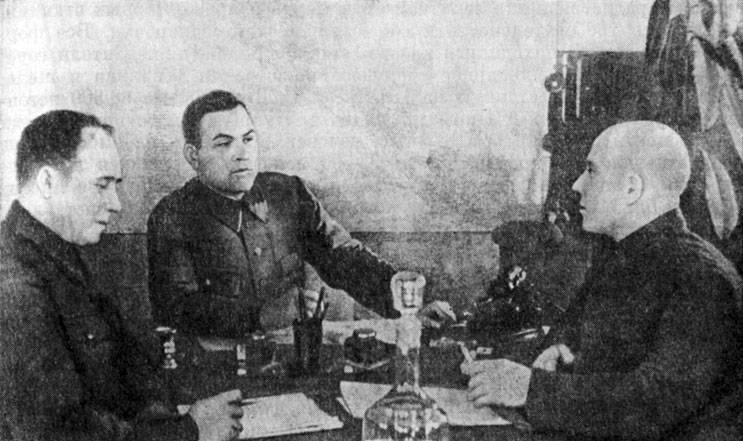
City Committee for the Defense of Stalingrad: A. I. Voronin, A. S. Chuyanov, I. F. Zimenkov
11 July The Stalingrad Defense Committee adopted a decree “On the state and measures to strengthen the units of the national militia”. It was decided to form a tank battalion of the people's militia in the Kirov region and additionally, in addition to the organized earlier, two battalions at the Tractor Factory. 14 July 1942 The city of Stalingrad was declared martial law. Stalingrad became a frontline city.
Since the autumn of 1941, great work has been done to prepare the city for defense. 13 October 1941 g. The State Defense Committee decided to build defensive lines on the approaches to Stalingrad. At that time, as German troops broke through in the Donbas, in the Stalingrad region, work was carried out on the construction of fortifications. They were conducted by the 5-th sapper army, the 5-m and 19-m directorates of the defenses of the NPO of the USSR with the involvement of the local population and the construction organizations of the region. The construction took place in a tense military situation and under adverse natural conditions of autumn and winter (rains, blizzards and severe frosts). About 200 thousand people took part in the works that continued in the winter. In January, 1942, the defensive lines of the Stalingrad and Astrakhan contours were transferred to the Military Council of the Stalingrad Military District by the 5 th sapper army. Stalingrad outer contour passed along the river. Ilovlya, north of Stalingrad, then along the left bank of the Don, along the r. Myshkov and to the Volga near Raygorod. Internal and middle contours were also built, but their readiness was no more than 40-50%.
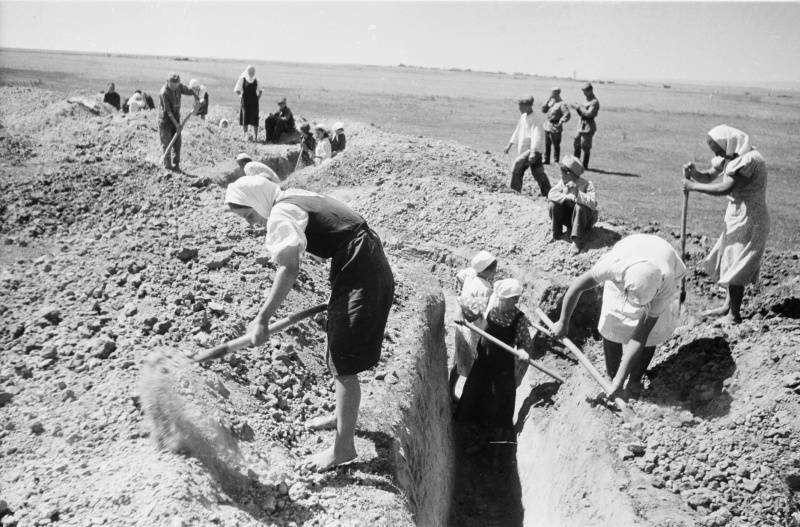
The construction of the trenches in the area of the river Don
In the spring of 1942, the lines that had not yet been completely constructed were flooded with water, and their condition was extremely unsatisfactory. Anti-tank ditches flooded everywhere and they collapsed, the upper layer of the earth washed away from the firing points, in many places the water carried off the overlapping logs. It also turned out that many of the firing points turned out to be unsuitable or unsuitable for use due to the lack of shelling space or its extreme limitation. Many embrasures were made too low or, conversely, high, there were other drawbacks. Thus, a major overhaul and improvement of the defensive line was required. The General Staff of the Red Army instructed the Stalingrad military district to restore the defensive lines. 13 June 24-th defensive construction department of the NKO of the USSR arrived in the Stalingrad region with construction battalions consisting of about 10 thousand people.
15 July 1942, the Stalingrad Regional Committee of the CPSU (b), in coordination with the Military Council of the Front, decided to urgently build a fourth defensive bypass, which was built on the outskirts of the city by citizens. Many thousands of Stalingrad workers went out on its construction every day. All work, often under the blows of enemy aircraft, was carried out by people with great patriotic enthusiasm. Many institutions, whose work could be stopped without damage to the front, were temporarily closed, and the whole team went to the construction of fortifications. Other institutions and enterprises allocated part of their employees. At the end of July and the first half of August, more than 57 thousand people went out for the construction of the city bypass. Everything needed for construction was sought on the ground. There was a mobilization of tools, equipment, building materials, horse-drawn and motor vehicles. Workers made metal hedgehogs, armored towers, reinforced concrete caps, precast pillboxes, etc. in factories and enterprises.
At the last stage of the construction of defensive fortifications, the leadership and control of the work were assigned to the headquarters of the 57 Army (from July 17). The headquarters of the army noted that the readiness of the lines in the fire system by this time reached only 5%. The main efforts of the 57 Army Headquarters were directed at eliminating this shortcoming. At the same time, the engineering units of the army began to mine the front edge. Also part of the army carried out work on disguise. In total, 2750 km of trenches and communication lines, up to 1860 km of anti-tank ditches and up to 85 thousands of different platforms and positions for fire weapons were built at the far and near approaches to Stalingrad. These were field-type facilities, which were not yet completely completed. But in general, during the Battle of Stalingrad, these fortifications, upgraded during the battles with the Germans, played an important role in the defense of the city.
Increased activity of German aviation. In May, 1942, the air defense service of the city and region, marked 297 airborne raids. On the night of July 23 Stalingrad suffered a strong air strike. In the following days, the raids systematically repeated. Under the air strikes were railway and water communications leading to Stalingrad, which greatly hampered the supply of troops and the population. The railway lines leading to the city were under the constant influence of enemy aircraft, and were largely incapacitated. The transport network in this area was poorly developed; there were no hard-surface roads here at all. As a result, the remaining iron lines of the Volga region worked with a huge overload and the role of the Volga waterway dramatically increased. All the growing cargo transportation for military factories and ammunition was assigned to the river transport of the Volga. In Volsk, Saratov, Kamyshin and Stalingrad, front supply bases were created, in Kazan, Syzran and Ulyanovsk, points of transshipment of goods from railways to water transport and back were urgently strengthened.
At the same time, the movement along the Volga waterway in the area of Stalingrad also sharply complicated. The German command sought to block the Volga fairway, block approaches to the city from both the upper and lower reaches of the river. In May, German planes dropped 212 magnetic-acoustic mines to the Volga water area, from 25 to 31 in July - 231 mine. By the end of July, the Volga was mined throughout the 400 km - from Kamyshin to Nikolsky. Since July 25, German aviation has fiercely bombed Volga ports and ships. All this led to serious losses. The mine blew up and the Smolensk steamer sank, the Kondom barge being towed by it was burned down. Killed 28 people. On July 26, the passenger ship Alexander Nevsky, three tugboats, four dry cargo ships and two oil barges were killed. A total of 25 July to 9 August from bombing and detonation of mines sank 25 self-propelled and 42 non-propelled vessel. However, despite the difficult conditions, active shipping on the Lower Volga was preserved. The movement of ships in the Stalingrad area did not stop either: from July 23 to August 23, Volga ships transported 40 thousand military cargoes, not counting economic transportation.
In conditions when communications leading to Stalingrad were under the blows of enemy aircraft, local enterprises played a special role in the defense of the city. The tractor plant produced tanks, tractors, diesel engines, repaired tanks. The plant "Red October" gave armor steel for tanks and other military products. The plant of the USSR People's Commissariat for Armaments produced high-speed weapons, mortars and ammunition. Ship repair enterprises built pontoons for ferries, re-equipped passenger boats to minesweepers, the ship repair plant in Krasnoarmeysky district began to produce armored boats. The hard work went on in the port.
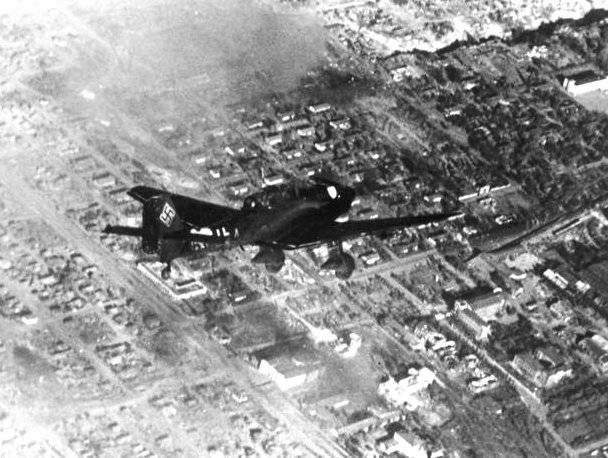
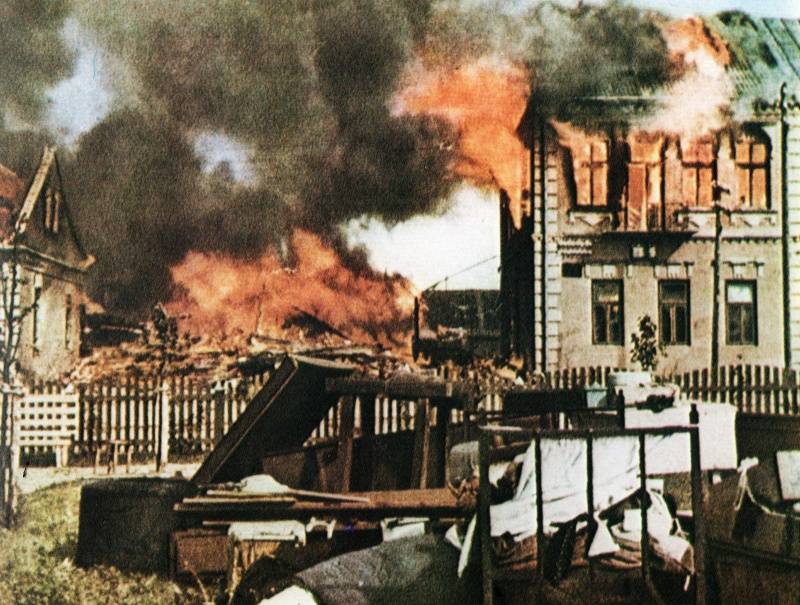
Fire in Stalingrad after a German air raid
To be continued ...
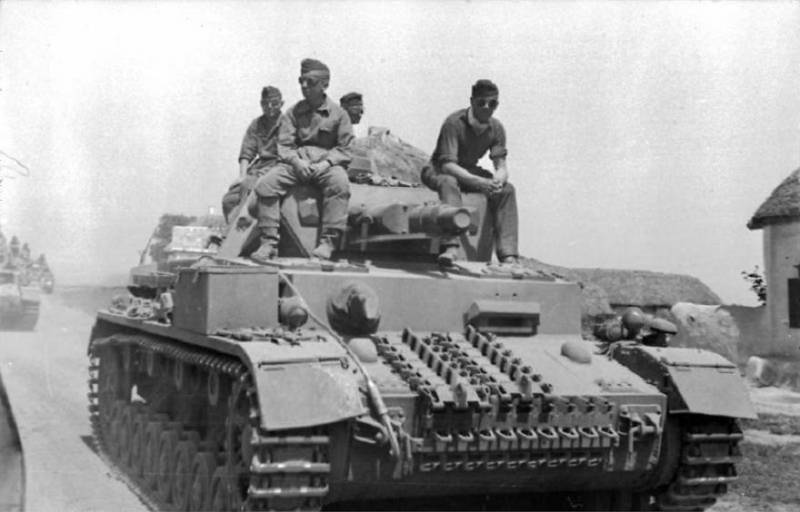
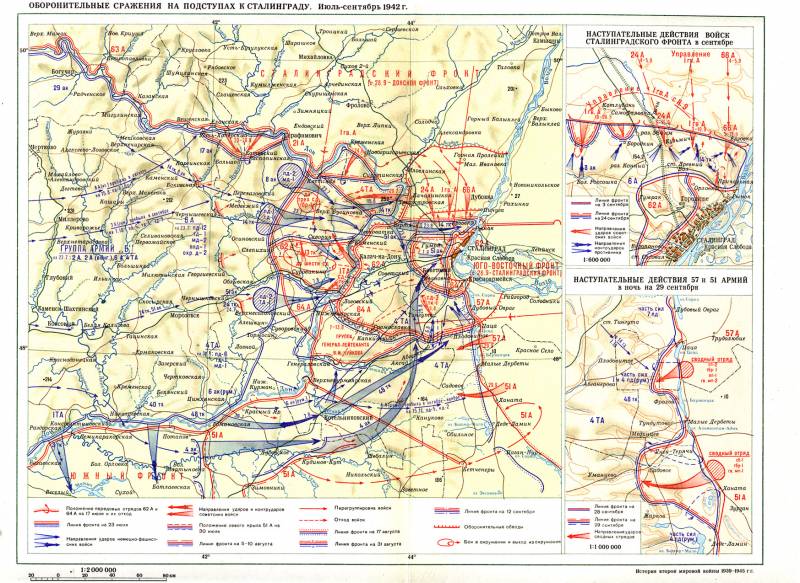
Information